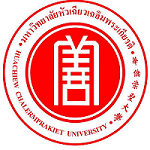Please use this identifier to cite or link to this item:
https://has.hcu.ac.th/jspui/handle/123456789/4844| Title: | ความเชื่อและพิธีกรรมที่เกี่ยวข้องกับศาลเจ้าแม่ทับทิมของคนไทยเชื้อสายจีนในย่านเยาวราช |
| Other Titles: | Beliefs and Rituals of Tuptim Goddess of Thai-Chinese People in Yaowarach Area |
| Authors: | Yulu Zhong แสงอรุณ กนกพงศ์ชัย Sangaroon Kanokpongchai Huachiew Chalermprakiet University. Faculty of Liberal Arts. Graduate Student Huachiew Chalermprakiet University. Faculty of Liberal Arts |
| Keywords: | ศาลเจ้าแม่ทับทิม Tuptim Goddess ความเชื่อ Belief and doubt ชาวจีน -- ไทย -- กรุงเทพฯ (เยาวราช) Chinese -- Thailand -- Bangkok (Yaowarach) พิธีทางศาสนาและพิธีกรรม Rites and ceremonies |
| Issue Date: | 2019 |
| Abstract: | การวิจัยเรื่องความเชื่อและพิธีกรรมที่เกี่ยวข้องกับศาลเจ้าแม่ทับทิมของคนไทยเชื้อสายจีนในย่านเยาวราช มีวัตถุประสงค์เพื่อศึกษาความเชื่อและพิธีกรรมที่เกี่ยวข้องกับศาลเจ้าแม่ทับทิมของคนไทยเชื้อสายจีนในย่านเยาวราช งานวิจัยนี้เป็นงานวิจัยเชิงคุณภาพเป็นการศึกษาจากเอกสารและการศึกษาจากภาคสนามด้วยวิธีการสัมภาษณ์เดี่ยว-รวมกลุ่มและสังเกตการณ์แบบมีส่วนร่วมและไม่ส่วนร่วม ผลการวิจัยพบว่า ศาลเจ้าที่ผู้วิจัยเลือกศึกษาคือ ศาลเจ้าแม่ทับทิมวัดเกาะ ศาลเจ้าแม่ประดู่ และศาลเจ้าอาม้าเก็ง นั้น แม้ในความเข้าใจของคนทั่วไปเป็นศาลเจ้าแม่ทับทิมตามการเรียกชื่อ (จากคติดั้งเดิมของคนไทยที่เชื่อในเรื่องผีนางไม้ จึงเกิดศาลเจ้าแม่ตะเคียน ศาลเจ้าแม่ทับทิม เป็นต้น) แต่การทำงานภาคสนาม กลับพบว่ารูปเคารพหลักในศาลกลับเป็นเจ้าแม่มาจู่ ซึ่งเป็นเทพสตรีอีกองค์หนึ่งที่มีฐานานุศักดิ์สูงกว่าเจ้าแม่ทับทิม ที่เป็นเพียงเทพท้องถิ่นของชาวจีนไหหลำ และเมื่อได้ศึกษาจากเอกสารไทย-จีนที่เกี่ยวข้องก็พบว่า เหตุที่ชาวไทยเชื้อสายจีนบางส่วนเรียกเทพสตรีสององค์นี้ สับสนกัน เนื่องจาก จีนไหหลำเป็นจีนกลุ่มแรกๆ ที่อพยพมาตั้งถิ่นฐานในไทยและนำรูปเคารพเจ้าแม่ทับทิมมาด้วย ภายหลังจีนอพยพกลุ่มต่อมา คือ จีนฮกเกี้ยน จีนแต้จิ๋ว จีนกวางตุ้ง ได้นำรูปเคารพที่ตนนับถือ คือ เจ้าแม่มาจู่ มาด้วยเช่นกัน นานวันไปคนส่วนใหญ่ทั้งไทยทั้งจีน จึงเรียกเจ้าแม่มาจู่เป็นเจ้าแม่ทับทิมไปด้วย จากชื่อของเครื่องทรงที่เป็นสีแดงทับทิม อย่างไรก็ตาม เนื่องจากเจ้าแม่ทั้งสององค์นี้ต่างก็มีตำนานและบทบาทที่ให้ความคุ้มครองคนเดินเรือเช่นเดียวกัน ต่อมาเมื่อผู้ศรัทธาเกิดความสมหวังจากพรที่ขอ เช่น การขอบุตร ขอให้สุขภาพแข็งแรง ค้าขายเจริญรุ่งเรือง ทำให้เจ้าแม่มาจู่ “ในศาลเจ้าแม่ทับทิม” ทั้งสามศาลนี้ ยังคงตอบสนองความต้องการของสังคมชายไทยเชื้อสายจีนในย่านเยาวราชมาจนถึงปัจจุบันน เพราะช่วยทำให้ศรัทธาเกิดความสบายใจ เชื่อมั่นและอบอุ่นใจจากปรากฏการณ์ที่ในเวลาปกติจะมีคนมาจุดธูปเทียนกราบไหว้พร้อมกับถวายเครื่องสักการะบูชาอื่น ๆ เช่น ผลไม้ ดอกไม้ ขนมและกระดาษเงินกระดาษทอง ส่วนในวันเทศกาลจะมีกิจกรรมอื่นๆ เช่น การทำสมาธิ อ่านพระคัมภีร์ ร้องเพลงและการแสดงงิ้ว นอกจากนี้ จากกระแสการเดินทางท่องเที่ยว พบว่าศาลเจ้าทั้งสามศาลนี้ ยังเป็นที่นิยมของนักท่องเที่ยวต่างชาติอีกด้วยทั้งจากสาธารณรัฐประชาชนจีน ไต้หวัน ฮ่องกง This research aims to study Thai-Chinese people in Yaowarat’s beliefs and warship towards Shui Wei Sheng Niang Shrines. This research is qualitative research which found that the selected shrines, which were “Wat Koh’s Shui Wei Sheng Niang Shrines”, “Chao Mae Pradu Shrine” and “A Ma Keng Shrine”, were recognized in general as Shui Wei Sheng Niang Shrines according to the name. After interview in depth, we found that the main respect icon in shrine were Mazu Goddess who was the goddess in higher Honorary than Shui Wei Sheng Niang who was only local deities for Hainanese. Moreover, after studying from related Thai-Chinese documents, we discovered that the reason why some Thai-Chinese people confused the name of these two goddess is that first Hainanese who settled in Thailand and brought the respect icon of Shui Wei Sheng Niang and later Hokkien. Chaozhou and Cantonese Chinese also brought the respect icon which was Mazu Goddess. Later, most of Thai and Chinese called Mazu Goddess as Shui Wei Sheng Niang because of the ruby costume and ornament. However, both goddesses have the same myth and role to protect the seafarers. After, her believers were satisfied with their blessing such as having baby, being healthy and having prosperous trade. Mazu Goddess in these three Shui Wei Sheng Niang shrines continues to meet the needs of Thai-Chinese Society in Yaowarat until present because this made the believers relief, confident and peaceful. In regular circumstance, the believers come to pay respects with incense and candles including offering fruits, flowers, desserts and gold paper. On the festive days, there are other activities such as meditation, reading bible, singing and Chinese opera. In addition, from the current travelling, these three shrines are popular among foreign tourists from Republic of China, Taiwan and Hong Kong. |
| Description: | การประชุมวิชาการระดับชาติ "มสธ.วิจัย" ประจำปี 2562 (STOU Research 2019) เรื่อง นวัตกรรมการวิจัย รับใช้สังคม วันที่ 18 มีนาคม 2562 ณ ห้องประชุม 104 อาคารพิทยพัฒน์ มหาวิทยาลัยสุโขทัยธรรมาธิราช จังหวัดนนทบุรี : หน้า 291-305. |
| URI: | https://has.hcu.ac.th/jspui/handle/123456789/4844 |
| Appears in Collections: | Liberal Arts - Proceeding Document |
Files in This Item:
| File | Description | Size | Format | |
|---|---|---|---|---|
| Beliefs-and-Rituals-of-Tuptim-Goddess-of-Thai-Chinese-People-in-Yaowarach-Area.pdf Restricted Access | 5.67 MB | Adobe PDF | View/Open Request a copy |
Items in DSpace are protected by copyright, with all rights reserved, unless otherwise indicated.
